Environmental change
Degradation through raw material production

Source: http://axisoflogic.com/artman/publish/Article_65840.shtml
Effects of agro-industrialization
Agro-industrialisation: the form of modern farming that refers to the industrialised production of livestock, poultry, fish and crops. It is typically large scale and capital intensive.
Source: http://www.thegeographeronline.net/environmental-change.html
The characteristics of these farms include:
Large scale
Use of machinery
Often specialisation in one or a limited number of products (monoculture)
IT management systems
Intensive use of chemicals
Low labour inputs in comparison to outputs
Often owned by agrobusiness companies (many of which are TNCs)
Maybe vertically integrated with food processing companies.
Source: http://greenfieldgeography.wikispaces.com/Degradation+through+raw+material+production
Agro-industrialization is all about improving yields in order to maximize profit by getting large quantities of uniform-quality food products in the shortest time interval possible. It is impossible to do so without a cost for the environment and also the farm animals' well being. Family farms from the beginning of the 20th century had to suffer a series of transformations to raise their productivity to the global market level. Some of them were:
- Intensification: This basically means increasing the output of a farm by increasing the amount grown or reared per hectare (one hectare = 10,000m2).
- Agro-industrialisation has happened and been able to happen for a number of reasons including:
- Mechanisation: The increased use of machine power over manpower.
- Land reclamation: Even though we can not increase the size of the planet that we live on, people have tried to increase the amount of land available to farming. This has involved deforestation and also land reclamation. Land reclamation is reclaiming land, usually from the water. In countries like the UK this has involved draining the fens in Cambridgeshire, Norfolk and Suffolk, in the Netherlands this has involved building a dyke and draining away the sea. In both circumstances, the land has been used for farming.
- Increased use of Chemicals: Increasing the use of fertilisers has allowed previously infertile land to be farmed. It has also meant that farmers need to do less crop rotation and leave less fallow periods. The use of pesticides has meant that less crops are lost to disease and pests allowing crops to be grown more intensively.
- Improved Irrigation: The greater use of irrigation (watering the ground) has allowed more areas to farmed for longer periods. This is especially true for very arid areas of the world like southern states in the US.
- Improved Transport (refrigeration and air freight): Faster transport and improved transport has meant that agricultural products can now be traded around the world. This has increased the number and size of farms looking to make a profit out of trading with other countries.
- Subsidies: Subsidies are financial inducements that reduce production costs make products cheaper and more competitive. The EU and countries like Japan and the US offer there farmers subsidies in order to increase production. The aim is to protect traditional industries and to aim for greater self sufficiency.
- Farm size: Traditionally farms have been handed down through generations and often even divided between siblings. This process reduced the size of farms, making many of them unproductive. This practice still happens in many LEDCs where subsistence farming is common. However, as countries develop and move towards commercial farming, they either cooperate and share resources (land, equipment, etc.) or farms merge together making larger plots of land. Larger farms allow for greater use of machinery and increase intensification.
- GM Crops: GM crops are genetically modified crops. This means that they have had their DNA altered through genetic engineering. Crops may have their DNA altered so that they grow faster, or grow bigger, or are more drought resistant, etc. GM crops are very controversial and have many critics as well as supporters. A summary of some of their many advantages and disadvantages is below.
Although agro-industrialisation has undoubtedly increased the world's agricultural output, reduced the cost of agricultural products and increased choice, it has also caused many problems. Some problems of agro-industrialisation include:
Overcultivation: The intensification of farming can lead to overcultivation. This basically means that too many crops are being grown in soil and it is not been given time to recover. If soil is overused then it will start to lose its fertility. This will either mean that it can be no longer used for agricultural purposes or that more fertilisers will have to be used. Once soil starts to lose its fertility it means that soil degradation is taking place. In an arid environment this might mean that desertification happens as well.
- Overgrazing: This means farming too many cattle on a piece of land. The result of this is that all the vegetation is eaten. This reduces the stability of the soil making it more vulnerable to wind and water erosion. When this happens the soil becomes degraded and desertification can take place in arid environments.
- Deforestation: To increase the number and size of farms, huge areas of forest are often cleared. This is a particular problem in countries like Brazil and Indonesia where areas of rainforest are being cleared to make way for cattle ranches and/or palm oil plantations.
- Increase use of chemicals (eutrophication): In order to farm more intensively more chemical are often used. This can damage local biodiversity and disrupt food webs, it can cause air pollution and eutrophication. Eutrophication is caused by fertilisers running off into lakes and rivers causing excessive algae growth. The excessive growth stops water being oxygenated properly and prevents it from receiving sunlight.
- Unsustainable Irrigation: Although irrigation can be very useful, it can also cause massive problems if it is done unsustainably. If more water is taken for irrigation than is being replaced then a number of problems may happen including; aquifer depletion, salinisation, saltwater intrusion and subsidence. A classic example of unsustainable irrigation in and around the Aral Sea. Here so much water has been taken from the two rivers that feed the Aral Sea, that the Aral Sea has stored to reduce in size and its salinity has increased (for more details see: Irrigation and agriculture).
- Greenhouse effect: Cattle (cows and pigs) produce large amounts of methane. Methane is one of the worst greenhouse gases. Therefore if the amount of cattle is increased so will the amount of greenhouse gases in the atmosphere increasing the greenhouse effect and global warming.
- Transportation: Agro-industrilisation has led to an increase in agricultural products being transported around the world. Many perishable products (fruit and vegetables) are transported by air or in refrigerated containers, both of which release large amounts of greenhouse gases.
- Disease: When you have a greater number of animals living in closer proximity there is a greater chance of disease spreading and being passed between species. Scrapies which started in sheep got passed to cattle (BSE) and then humans CJD. Other diseases which have spread quickly and been transmitted to humans include swine flu, bird flu and foot and mouth disease.
- Animal cruelty: Industrial farming has been blamed for animal cruelty that takes place on some farms. This might include living in very cramped conditions (battery chickens), being forced fed (geese being reared to produce foie gras), being kept in dark conditions (cows being reared for veal), fed unnatural foods or transported over long distances.
Source: http://greenfieldgeography.wikispaces.com/Degradation+through+raw+material+production
Increasing international demand - Palm oil
Palm oil is an edible plant oil derived from the palm tree. Palm oil is extracted from the pulp of the fruit and is naturally reddish in colour. Palm oil is used in a huge variety of products and has multiple functions. Common food products like chocolate, butter, cereals, pizza, bread and crisps can all contain palm oil. Cleaning products and make up products can also contain palm oil and it can obviously be used as a cooking oil as well as a biofuel.
Indonesia is the world's biggest producer of palm oil, followed by Malaysia. Between them they grow over 80% of the world's palm oil. Nigeria is the third biggest producer. Other tropical countries like Columbia, Thailand and the Ivory Coast also produce palm oil.
Despite its wide variety of uses, palm oil has many critics because of the environmental damage that growing it can cause. To make way for plantations large areas of rainforest are often cleared. This destroys the habitats of endangered species like the orangutan and tiger, as well as forcing indigenous groups off their land. Deforestation and drainage of peaty soils (beneath Malaysian and Indonesian rainforests) also releases large quantities of stored carbon, therefore enhancing the greenhouse effect still further. New transport and communication links into the rainforest can cause further disruption to habitats and pollution. Any form of agriculture and extraction can use chemicals and machinery which can lead to leaks causing air and water pollution. Obviously transporting palm oil all over the world can also cause pollution and contribute to the greenhouse effect and then their final burning if they are used as biofuels releases pollution. Palm oil has also been blamed on food shortages and rising food prices as more land is dedicated to biofuels rather than food crops.
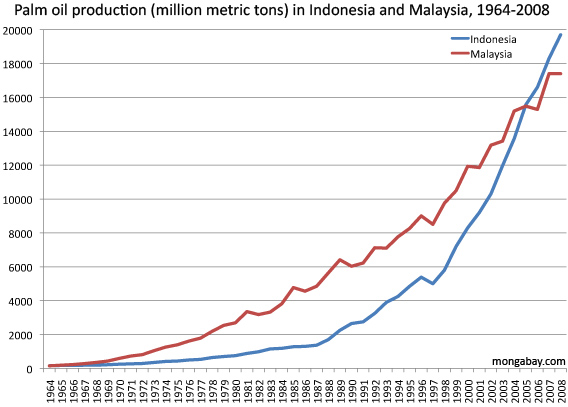
Source: http://greenfieldgeography.wikispaces.com/Degradation+through+raw+material+production
Food miles
Food miles are defined as the distance food travels from where it is produced to where it is eaten. In many LEDCs people are subsistence farmers so only eat products that they have produced themselves. However, as countries develop people start expecting a greater variety of foods and they expect foods to be available all year. These changes in taste, coupled with the improvements in transport and refrigeration have drastically increased food miles.
It is possible to transport many food products by road, rail and ship as long as they have a long shelf life e.g. dry pasta, rice, tins, cereals, biscuits, wine, etc. However, it is necessary to transport perishable products like fruit and vegetables by air. Air is the most polluting form of transport and contributes significantly to the greenhouse effect. In the UK it is estimated that 1% of food is transported by air, but it accounts for over 11% of carbon emissions.
However, some people say that it is far too simplistic just to look at the number of food miles when calculating the environmental impact of food. People argue that it is environmentally more sustainable to grow tomatoes in Spain than the UK because it is not necessary to heat greenhouses. It is also argued that it is better to grow rice in a tropical country like Vietnam than trying to grow it in the US. To look at a foods entire environmental impact from planting to eating is known as life cycle analysis.

Source: http://greenfieldgeography.wikispaces.com/Degradation+through+raw+material+production
The effects of transnational manufacturing and services
Externalities
Externalities: An impact or affect that is caused by an unconnected event or process. Externalities can be both positive or negative.
Negative externalities usually affect poor people the most. Poor people tend to be people who are forced to live near polluting factories because they can't afford to live anywhere else. The old/young and sick are also vulnerable to pollution caused by industry. Many polluting industries also choose to locate in LEDCs for a number of reasons including:
Negative externalities usually affect poor people the most. Poor people tend to be people who are forced to live near polluting factories because they can't afford to live anywhere else. The old/young and sick are also vulnerable to pollution caused by industry. Many polluting industries also choose to locate in LEDCs for a number of reasons including:
- More relaxed environmental regulations
- Less enforcement of environmental regulations (this might be because they can't afford to enforce, because they are being paid to overlook (corruption), or they are worried about losing FDI.
- Access to a new potential marketplace
- Access to raw materials (which again might be extracted using polluting methods)
- Availability of cheap labour
- Cheap land and building materials (possibly relaxed building regulations)
Kuznets Curve

The Kuznets curve represents Simon Kuznets's theory. Initially the curve was developed to show how economic inequality changes as a country develops. However, the curve has also been applied to show how environmental degradation changes over time. It basically says in the early stage of development the main priority of any country is development. However, after a certain standard of living is reached (the tipping point) there is an increased emphasis on pollution, both by individuals, countries and companies. At this point the investment in the environment increases and the quality of the environment increases. The emphasis on the environment increases for a number of reasons including:
- People have a comfortable standard of living
- People have increased leisure time and disposable income
- People have increased awareness of environmental issues (news, education)
- People spend more time enjoying the environment (holiday, sport, recreation, etc.)
Source: http://greenfieldgeography.wikispaces.com/The+effects+of+transnational+manufacturing+and+services
Relocating polluting industries - Maquilladoras in Mexico
Definition of Maquiladoras
Foreign-owned assembly plants in Mexico. Companies import machinery and materials duty free and export finished products around the world. They are also known as twin plants, maquilas and in-bond industries.
Source: http://www.corpwatch.org/article.php?id=1528
Since the 1960s, maquiladoras or export assembly plants have been the cornerstone of Mexico’s strategy to attract foreign direct investment and boost exports. But the environmental and social costs have been high.
Maquiladoras, which in Mexico mainly produce clothing, cars and electronic equipment, consume huge volumes of water, generate hazardous waste products like alcohols, benzene, acetone, acids and plastic and metal debris, and emit polluting gases.
The plants, which take advantage of Mexico’s low wages, tax exemptions, and flexible labour laws while in return providing jobs, cause significant environmental damages.
“Government oversight is poor. There aren’t enough inspectors. There is no obligatory inspection scheme, only a voluntary one, and inspections are arranged in advance, with no surprise visits,” Magdalena Cerda, the Tijuana representative for the Environmental Health Coalition (EHC), told IPS. “We have seen gradual deterioration in the urban communities where the factories are located.”
Maquiladoras have been criticised for their use of dangerous substances. For instance, in order to increase smoothness and strength in fabrics for making clothes, they are treated with chemicals such as formaldehyde, caustic soda, sulphuric acid, bromine and sulphamide, all of which are health hazards, according the U.S. Organic Consumers Association.
The industrial processes of cleaning, spinning, weaving or knitting and finishing an item of apparel generate an average of 1.4 kg of carbon dioxide (CO2), one of the main greenhouse gases responsible for global warming, according to The Story of Stuff Project, developed by U.S. author and web host Annie Leonard.
Producing one computer chip takes 20 litres of water, 45 grams of chemicals and 1.8 kilowatt-hours of electricity, and spews out 17 kg of liquid residues and 7.8 kg of solid waste, according to the United Nations University.
Computers contain dangerous heavy metals and other elements, including barium, lead, mercury, beryllium and cadmium.
“Mexico cannot afford to regulate this sector adequately; we lack methods for solving these issues. Investment in clean technology reduces the profit margin, but we know that it is more expensive to remediate pollution,” said EHC’s Cerda.
As an outcome of the 1983 BECA agreement, the Mexican and U.S. governments drew up a collaborative environmental health programme known as Border 2012, aimed at reducing soil, air and water pollution, improving environmental health and ensuring emergency preparedness along the Mexico-U.S. border.
Source: http://www.ipsnews.net/2011/08/mexico-maquiladora-factories-manufacture-toxic-pollutants/
Hazardous conditions within the maquiladoras are just the beginning of the problem. The presence of the maquiladoras combined with loosely enforced Mexican environmental laws and a lack of suitable waste storage and treatment facilities, cause the border area to be among the most polluted in Mexico. Even in the event that one of the factories is shut down for environmental reasons, that does not necessarily mean an end to the factory's pollution to the surrounding community. Metales y Derivados, a lead-smelting facility in Tijuana, was shut down in 1994 when its owners failed to comply with toxic waste disposal laws. However, the waste was never properly treated and/or relocated and is currently leaking through its containers, seeping into the ground, and contaminating community's water supply (Global Exchange, 2000).
Source: http://umich.edu/~snre492/Jones/maquiladora.htm
Air pollution is a great concern along the border.� Border residents are exposed daily to extremely high air-pollutant levels including high levels of carbon monoxide.� Deteriorating water quality is another concern along the border.� There is a considerable amount of pollution that is dumped into the Rio Grande, poisoning wildlife and communities all along the river and causing a much greater Hepatitis A risk (Public Citizen, 1998b).�
Source: http://umich.edu/~snre492/Jones/maquiladora.htm
Relocating waste - Trafigura
On 19 August 2006 the ship Probo Koala unloaded a waste shipment at Abidjan, Côte d’Ivoire (Ivory Coast). This waste was disposed of at open air sites around Abidjan. The ship was chartered by the London office of Trafigura, a Dutch international petroleum trader. The Probo Koala had attempted to discharge this waste at the port of Amsterdam, but the port service would not accept the waste without an additional handling charge because of the waste’s alleged toxicity. The ship left the port of Amsterdam without discharging its waste. After the waste from the ship was discharged in Abidjan, people living near the discharge sites began to suffer from a range of illnesses (nausea, diarrhea, vomiting, breathlessness, headaches, skin damage, and swollen stomachs). Sixteen people have died, allegedly from exposure to this waste, and more than 100,000 have sought medical attention.
Trafigura sent two of its executives to Abidjan in August 2006 to investigate what happened. These executives and a representative from a Trafigura subsidiary, Puma Energy, were arrested by Ivorian authorities and imprisoned. On 12 February 2007 the Government of Côte d’Ivoire signed a settlement agreement with Trafigura in which the company agreed to pay $198 million to the Ivorian government for a compensation fund, the construction of a waste treatment plant and to assist in the recovery operations. However, the company stressed this payment was not "damages" and that it did not admit liability. Côte d’Ivoire agreed to drop any prosecutions or claims, now or in the future, against Trafigura. After this settlement agreement was made, the Trafigura executives and the Puma Energy representative were released from prison.
In October 2009 an individual, Claude Gohourou, came forward claiming to represent the victims through his organization - National Coordination of Toxic Waste Victims of Côte d’Ivoire. Mr Gohourou succeeded in freezing the bank account in which the settlement funds were being held. The claimants' lawyers dispute the authenticity of this organization and Mr Gohourou's authority to distribute the funds to the claimants. On 22 January 2010, the Court of Appeals in Abidjan ruled in favour of Mr Gohourou and his organization and ordered the settlement funds be transferred to him. In mid-February 2010 the parties reached an agreement about the distribution of the settlement funds. However, 6000 of the victims still have not received the compensation.
In June 2016, the High Court ruled that Leigh Day, the law firm representing the victims, should compensat the victims that had not received compensation due to the breach of its its duty of care. Leigh day declared: "...were devastated when some of the monies were misappropriated. We did our damnedest to recover the monies resulting in the great majority of our clients having received their compensation."
Source: https://business-humanrights.org/en/trafigura-lawsuits-re-c%C3%B4te-d%E2%80%99ivoire
Transboundary pollution
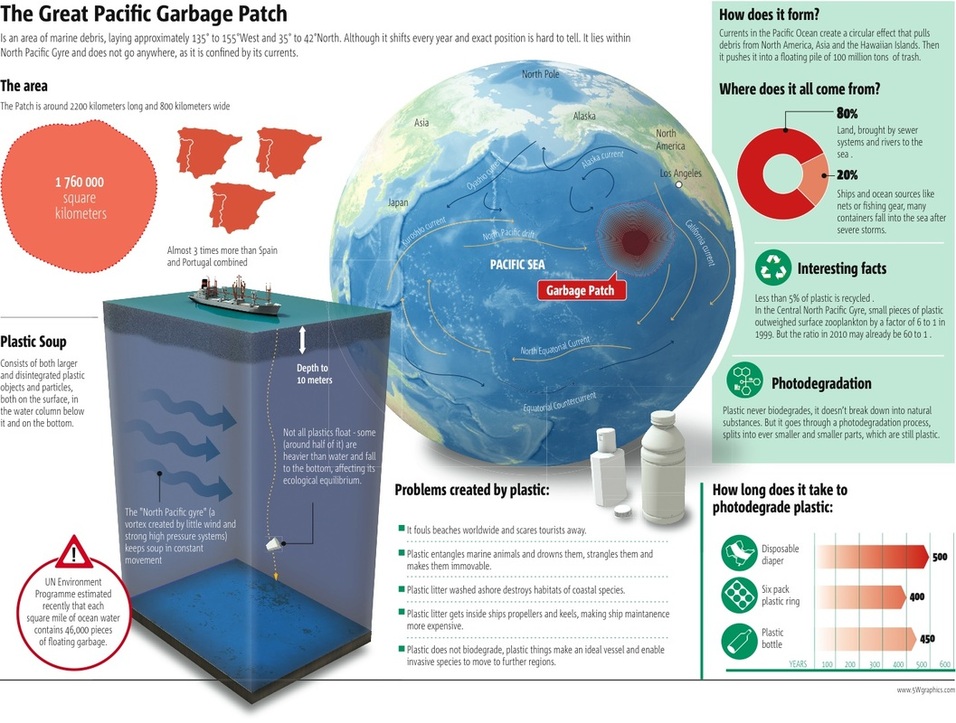
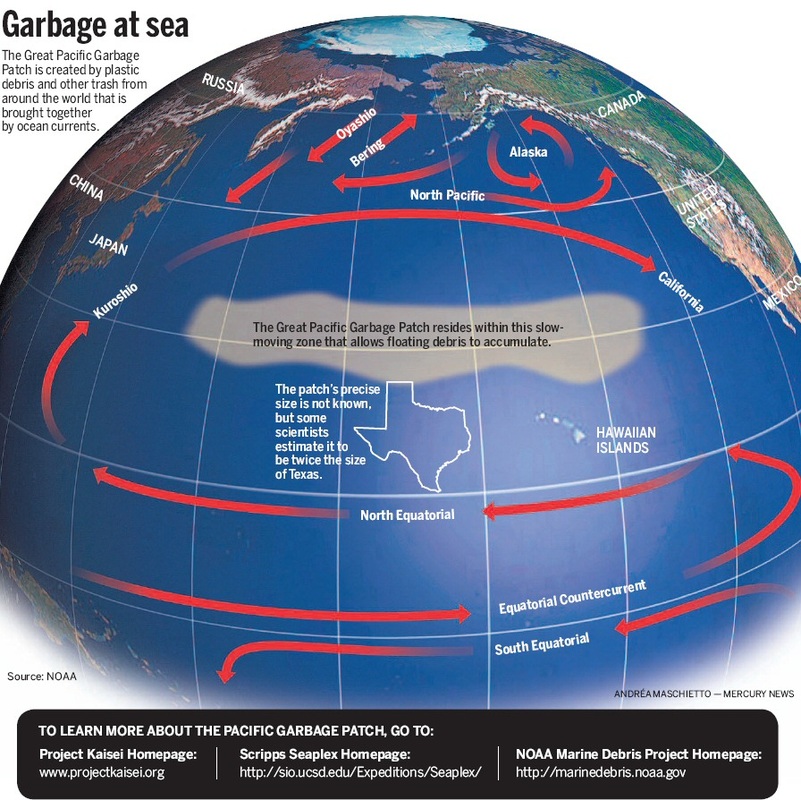
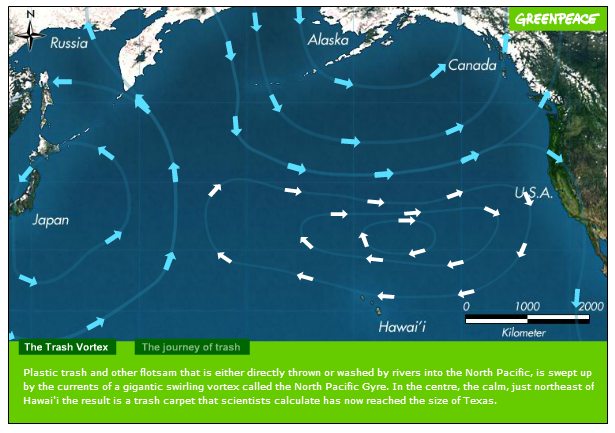
Source: http://www.thegeographeronline.net/environmental-change.html
Growth of environmental awareness
As suggested by the Kuznets curve, environmental awareness increases with economic development. Environmental awareness increases because:
- Increased publicity and campaigning by NGOs and charitable organisations e.g. Greenpeace
- Increased coverage of environmental problems by media organisations e.g. BBC and CNN
- Environmental disasters like the BP Oil Spill have heightened awareness
- Improved economic development allows people to consider other matters rather than just the economy and making money
- Because people have more leisure time and greater disposable income they have more time to enjoy the environment so would like it protected
- Government have created more protected areas e.g. National Parks as well as the UN e.g. World Heritage Sites which has increased the profile of the environment
- Political parties like the Green party in the UK are growing in importance and stature and are increasing people awareness
- Environmental campaigns can be spread easily via social media like Youtube, Twitter and blogs
- Education about the environment e.g. the three R (reduce, reuse, recycle) has improved at school
- The number of recycling centres and recycling bins have increased which has increased awareness
- Environmental labelling e.g. FSC and Dolphin Friendly have made consumers more aware of the environment
- The environment has been made one of the Millennium Development Goals - Goal 7 is Environmental Sustainability
- UN conferences like the Rio Earth Summit have increased global awareness of the environment
- Global issues like acid rain, the greenhouse effect and the hole in the ozone layer are better understood and better publicised and taught
Source: http://greenfieldgeography.wikispaces.com/Transboundary+pollution
The role of WWF
WWF's mission is to stop the degradation of our planet's natural environment, and build a future in which people live in harmony with nature.
In order to achieve this mission, WWF broadly focuses its efforts on two broad areas:
- Biodiversity - to ensure that the earth web of life stays healthy and vibrant for generations to come.
- Footprint - reducing the negative impacts of human activity - our ecological footprint - and that the use of natural resources required for life are managed sustainably and equitably.
Homogenization of landscapes
Factors that have caused global urban uniformity
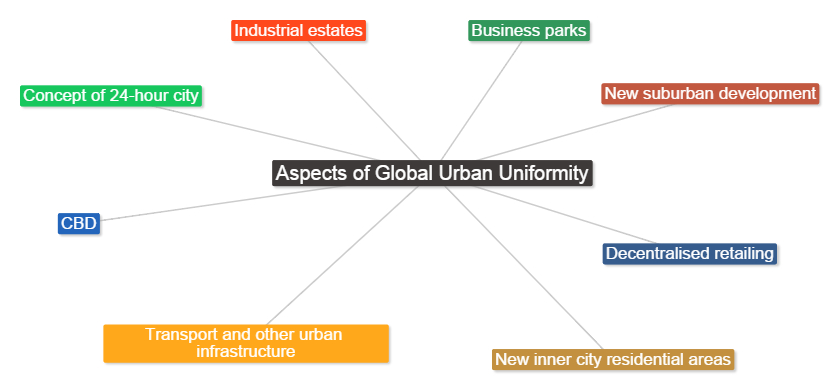
Source: http://www.thegeographeronline.net/environmental-change.html
Clone Towns
The term clone town was first used by the New Economic Forum in 2004. It was used to describe the state of some British towns, The term simply means that the centres of main towns have become dominated by the same chain stores, making them all very similar. The report said that the growth of clone towns was very damaging because:
- Small independent businesses were lost
- Choice was reduced as chain stores only stocked limited profitable lines
- The chain stores had too much power and often treated suppliers unfairly. Suppliers were often to scared to criticise in case they lost business
- Many chain stores relocated to out of town shopping malls and retail parks, damaging CBDs, damaging the rural-urban fringe and increasing prices, congestion and pollution in the rural-urban fringe.
- Regional identity reduced as all supermarkets stocked the same food and products.
In 2005 the city of Exeter was discovered to have only one independent store on its entire high street.
Americanisation, Westernisation, Disneyfication, Mcdonaldlisation
All these processes refer to the adoption of different aspects of western culture. The west is considered to be Western Europe and North America. In the past westernisation has happened through colonisation, but it has increasingly happened through economic dominance and political pressure. Although Iraq and Afghanistan could be recent examples where the military has been used to impose ideas and beliefs. Aspects of culture that maybe adopted include:
- Law
- Politics
- Music, food, clothes, film, language etc.
- Economics (brands, economic system (capitalism) and companies)
Westernisation whether deliberate or not can be blamed on the loss of local cultures and speeding up the process of homogenisation.
Source: http://greenfieldgeography.wikispaces.com/Homogenization+of+landscapes

This comment has been removed by a blog administrator.
ReplyDelete